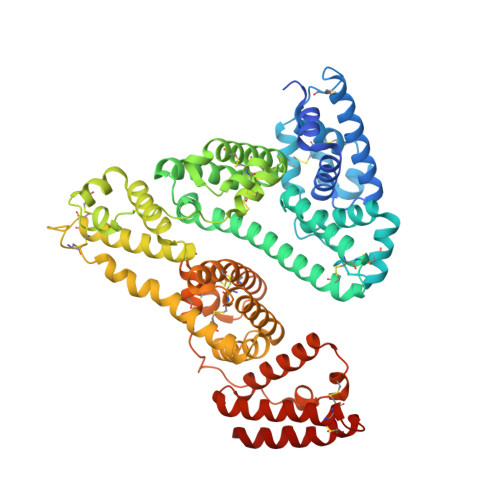Synthetic Cationic Antimicrobial Peptides Bind with Their Hydrophobic Parts to Drug Site II of Human Serum Albumin.
Sivertsen, A., Isaksson, J., Leiros, H.S., Svenson, J., Svendsen, J., Brandsdal, B.O.(2014) BMC Struct Biol 14: 4
- PubMed: 24456893
- DOI: https://doi.org/10.1186/1472-6807-14-4
- Primary Citation of Related Structures:
4BKE - PubMed Abstract:
Many biologically active compounds bind to plasma transport proteins, and this binding can be either advantageous or disadvantageous from a drug design perspective. Human serum albumin (HSA) is one of the most important transport proteins in the cardiovascular system due to its great binding capacity and high physiological concentration. HSA has a preference for accommodating neutral lipophilic and acidic drug-like ligands, but is also surprisingly able to bind positively charged peptides. Understanding of how short cationic antimicrobial peptides interact with human serum albumin is of importance for developing such compounds into the clinics. The binding of a selection of short synthetic cationic antimicrobial peptides (CAPs) to human albumin with binding affinities in the μM range is described. Competitive isothermal titration calorimetry (ITC) and NMR WaterLOGSY experiments mapped the binding site of the CAPs to the well-known drug site II within subdomain IIIA of HSA. Thermodynamic and structural analysis revealed that the binding is exclusively driven by interactions with the hydrophobic moieties of the peptides, and is independent of the cationic residues that are vital for antimicrobial activity. Both of the hydrophobic moieties comprising the peptides were detected to interact with drug site II by NMR saturation transfer difference (STD) group epitope mapping (GEM) and INPHARMA experiments. Molecular models of the complexes between the peptides and albumin were constructed using docking experiments, and support the binding hypothesis and confirm the overall binding affinities of the CAPs. The biophysical and structural characterizations of albumin-peptide complexes reported here provide detailed insight into how albumin can bind short cationic peptides. The hydrophobic elements of the peptides studied here are responsible for the main interaction with HSA. We suggest that albumin binding should be taken into careful consideration in antimicrobial peptide studies, as the systemic distribution can be significantly affected by HSA interactions.
Organizational Affiliation:
The Norwegian Structural Biology Centre, Department of Chemistry, Faculty of Science and Technology, University of Tromsø, NO-9037 Tromsø, Norway. bjorn-olav.brandsdal@uit.no.















